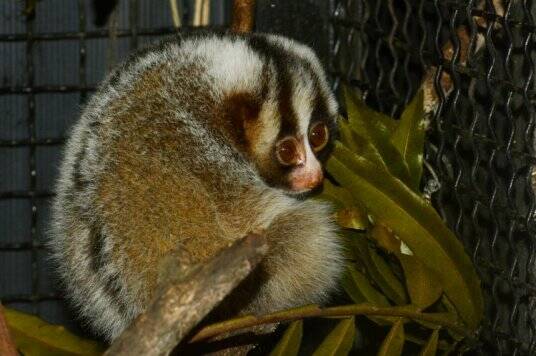Nycticebus borneanus
IUCN
LCBasic Information
Scientific classification
- name:Nycticebus borneanus
- Scientific Name:Nycticebus borneanus,Bornean Slow Loris
- Outline:Primates
- Family:S.loris
Vital signs
- length:About 26 cm
- Weight:200-300g
- lifetime:About 10 years
Feature
The fur on the body is very long and fluffy, almost like that of an adult cat.
Distribution and Habitat
It is found only on the Indonesian island of Kalimantan. It is found in south-central Borneo (western, southern, and central Kalimantan, but not including the southwestern tip), south of the Kapuas River and eastwards to the Barito River. This species may coexist with the Kayan River slow loris or the Philippine slow loris in some areas.
Appearance
The average body length of the Kalimantan slow loris is 26 cm. Like other slow lorises, it has a rounded head, short ears, and a vestigial tail. The exposed surface around the nasal cavity is moist, and it has a broad, flat face and large eyes. They, like all other Bornean species, lack a second upper incisor, which distinguishes them from other lorises. On their front paws, the second digit is smaller than the other digits; the big toe of the hind paw is relatively longer than the other toes, which enhances their grip. The second toe of the hind paw of the Kalimantan slow loris has a curved grooming claw on it, which is used for scratching and grooming, while the other nails are straight. The species also possesses a specially arranged lower incisor, called a tooth comb, which is also used for grooming. Like other lemur-like primates, there is also a small bump on the ventral side of the elbow, called the brachial gland, which secretes a pungent, transparent, oily toxin that is wiped
Details
Kalimantan slow loris (scientific name: Nycticebus borneanus), foreign name Bornean Slow Loris, no subspecies.

The Kalimantan slow loris is nocturnal and arboreal, rarely going to the ground. It spends its activities, foraging, mating, reproduction and hibernation in trees. During the day, it curls up in a ball and hides in the tree holes of tall trees, near the lush canopy of branches and leaves, or on the forks of dense branches to rest. It starts to move around and forage after dusk. They like to move alone, move very slowly, mostly climbing, and do not jump. They only speed up when attacked. They are slow and deliberate climbers, often holding on to branches with three of their limbs. In order to move between trees, they carefully grasp the terminal branches of nearby trees and pull themselves through small gaps. They will also hold branches with only their hind feet, lift themselves up, and quickly pounce forward with their hands to eat.
The Kalimantan slow loris is an omnivorous animal, and its food includes tropical fresh flowers, leaves and berries, insectivorous and other arthropods, small birds and reptiles, eggs, fruits, gums, nectar and other vegetation. It usually forages alone all night. It is good at preying on sleeping birds at night and likes to eat bird eggs and honey.
Listed in the IUCN Red List of Threatened Species in 2015 ver3.1 - Vulnerable (VU).
Protect wild animals and eliminate game.
Maintaining ecological balance is everyone's responsibility!








